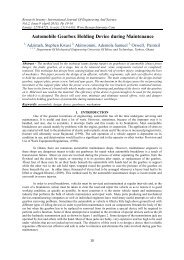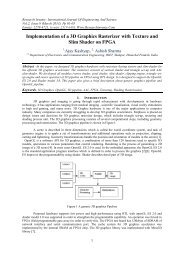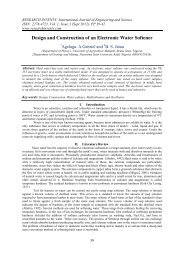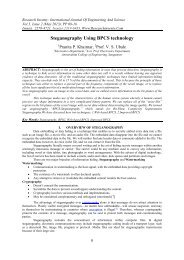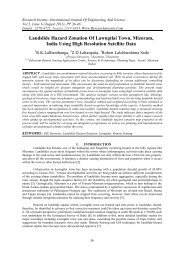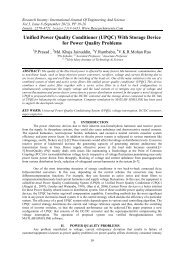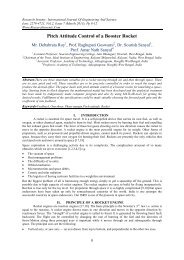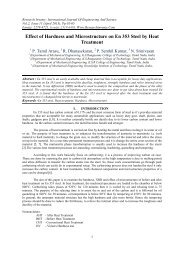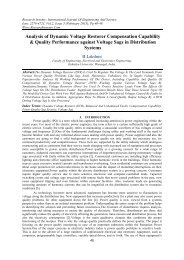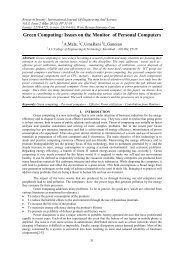Zero-free Regions for Polynomials with ... - Research Inventy
Zero-free Regions for Polynomials with ... - Research Inventy
Zero-free Regions for Polynomials with ... - Research Inventy
Create successful ePaper yourself
Turn your PDF publications into a flip-book with our unique Google optimized e-Paper software.
<strong>Research</strong> <strong>Inventy</strong>: International Journal Of Engineering And ScienceIssn: 2278-4721, Vol. 2, Issue 6 (March 2013), Pp 06-10Www.<strong>Research</strong>inventy.Com<strong>Zero</strong>-Free <strong>Regions</strong> <strong>for</strong> <strong>Polynomials</strong> With Restricted CoefficientsM. H. GulzarDepartment of Mathematics University of Kashmir, Srinagar 190006Abstract : According to a famous result of Enestrom and Kakeya, ifnn1P( z) anz an1z ...... a1z a0is a polynomial of degree n such that0 an an 1 ...... a1 a0,then P(z) does not vanish in z 1. In this paper we relax the hypothesis of this result in several ways andobtain zero-<strong>free</strong> regions <strong>for</strong> polynomials <strong>with</strong> restricted coefficients and thereby present some interestinggeneralizations and extensions of the Enestrom-Kakeya Theorem.Mathematics Subject Classification:30C10,30C15Key-Words and Phrases: <strong>Zero</strong>-<strong>free</strong> regions, Bounds, <strong>Polynomials</strong>1. Introduction And Statement Of ResultsThe following elegant result on the distribution of zeros of a polynomial is due to Enestrom andKakeya [6] :Theorem A : IfnP j( z ) a z jis a polynomial of degree n such thatj0an an 1 ...... a1 a0 0,then P(z) has all its zeros in z 1.1Applying the above result to the polynomial z n P( ) , we get the following result :zTheorem B : IfnP j( z ) a z jis a polynomial of degree n such thatj00 an an 1 ...... a1 a0,then P(z) does not vanish in z 1.In the literature [1-5, 7,8], there exist several extensions and generalizations of the Enestrom-Kakeya Theorem .Recently B. A. Zargar [9] proved the following results:Theorem C: LetnP j( z ) a z jbe a polynomial of degree n . If <strong>for</strong> some real number 1j00 an an 1 ...... a1 ka0,then P(z) does not vanish in the diskTheorem D: Let1z .2 k 1k ,, 0 a ,nP j( z ) a z be a polynomial of degree n . If <strong>for</strong> some real numberj nj00 an an1 ...... a1 a0,then P(z) does not vanish in the disk6
Theorem E: Letthen P(z) does not vanish inTheorem F: Let1z 2.1 a0<strong>Zero</strong>-<strong>free</strong> <strong>Regions</strong> <strong>for</strong> <strong>Polynomials</strong> <strong>with</strong> Restricted CoefficientsnP j( z ) a z jbe a polynomial of degree n . If <strong>for</strong> some real number 1j0kan an 1 ...... a1 a0 0 ,a0z 2ka.na0nP zj) a z jj0k ,( be a polynomial of degree n . If <strong>for</strong> some real number 0,,an an 1 ...... a1 a0 0 ,then P(z) does not vanish in the diska0z .2(an ) a0In this paper we give generalizations of the above mentioned results. In fact, we prove the following results:Theorem 1: LetnP j( z ) a z jbe a polynomial of degree n . If <strong>for</strong> some real numbers 1j0k and 0, ,an an1 ...... a1 ka0,then P(z) does not vanish in the diska0z .k( a0 a0) a0 2 a n a nRemark 1: Taking 0 an, Theorem 1 reduces to Theorem C and taking k=1 and 0 an, , itreduces to Theorem D.Theorem 2: LetnP j( z ) a z jbe a polynomial of degree n . If <strong>for</strong> some real numbers 0j00 1,an an 1 ...... a1a0,then P(z) does not vanish ina0z 2 a a ( a a ) aRemark 2: Taking 1n 0n000. and and a 0 , Theorem 1 reduces to Theorem F and taking 1 , 0 ( k 1)a , k 1, it reduces to Theorem E .nAlso taking ( k 1)an, k 1and 1.Theorem 3: Leta and , we get the following result which reduces to Theorem E by taking a 0nP j( z ) a z jbe a polynomial of degree n . If <strong>for</strong> some real numbers 1,01j0kan an 1 ...... a1a0,then P(z) does not vanish in the disk0 0 k ,7
<strong>Zero</strong>-<strong>free</strong> <strong>Regions</strong> <strong>for</strong> <strong>Polynomials</strong> <strong>with</strong> Restricted Coefficientsza 0.2ka (1 2) an02.Proofs of the TheoremsProof of Theorem 1: We havenn1P( z) anz an1z ...... a1z aLetn 1Q(z) z P()zandF( z) ( z 1)Q(z).ThenFor z 1, 0.n n1F( z) ( z 1)(a0z a1z...... an1z an)n1nn1 az [( a a ) z ( a a ) z ...... ( a a z0 0 11 2n2n1) a a ) z a ] .(n 1 n nn1nn10 nz anF( z) a z [a0 a1z a1 a2z ...... an1 aif azn1a1 a2an1 a[ z { a0 a1 ...... n1a0zz0 nn 1 a0 z [ z { ka0 a1 ka0 a0 a1 a2 ...... an 1 an aa0 a n}]1[ z {( ka 0a ) 1( k 1) a 0( a 1a2) ...... ( a n2an1)an0z0 ( an 1 an ) an}]n 1 a0z [ z { k(a0 a0) a0 an an 2}]a 001z [ k(a0 a0) a0 a n an 2].a0This shows that all the zeros of F(z) whose modulus is greater than 1 lie in the closed disk1z [ k(a0 a0) a0 a n an 2].a0But those zeros of F(z) whose modulus is less than or equal to 1 already lie in the above disk. There<strong>for</strong>e, itfollows that all the zeros of F(z) and hence Q(z) lie in1z [ k(a0 a0) a0 a n an 2].a0n 11Since P(z) z Q() , it follows, by replacing z by , that all the zeros of P(z) lie inzz8nazn}]]2
a0z .k( a0 a0) a0 a n a n 2Hence P(z) does not vanish in the diska0z .k( a0 a0) a0 a n a n 2That proves Theorem 1.Proof of Theorem 2: We havenn1P( z) anz an1z ...... a1z aLetn 1Q(z) z P()zandF( z) ( z 1)Q(z).ThenFor z 1,<strong>Zero</strong>-<strong>free</strong> <strong>Regions</strong> <strong>for</strong> <strong>Polynomials</strong> <strong>with</strong> Restricted Coefficients 0.n n1F( z) ( z 1)(a0z a1z...... an1z an)n1nn1 az [( a a ) z ( a a ) z ...... ( a a z0 0 11 2n2n1) a a ) z a ] .(n 1 n nn1nn10 nz anF( z) a z [a0 a1z a1 a2z ...... an1 aif azn1a1 a2an1 a[ z { a0 a1 ...... n1a0zz0 nn 1 a0 z [ z { a0 a1a0 a0 a1 a2 ...... an 1 ana a09nazn}]]2 a n}]1[ z {( a1a0) (1 ) a0 ( a2 a1) ...... ( an an1)an0z0 a n}]n 1 a0z [ z { a0( a0 a0) an an 2}]a 001z { a0( a0 a0) a n an 2}.a0This shows that all the zeros of F(z) whose modulus is greater than 1 lie in the closed disk1z { a0( a0 a0) a n an 2}.a0But those zeros of F(z) whose modulus is less than or equal to 1 already lie in the above disk. There<strong>for</strong>e, itfollows that all the zeros of F(z) and hence Q(z) lie in1z { a0( a0 a0) a n an 2}.a0
<strong>Zero</strong>-<strong>free</strong> <strong>Regions</strong> <strong>for</strong> <strong>Polynomials</strong> <strong>with</strong> Restricted Coefficientsn 11Since P(z) z Q() , it follows, by replacing z by , that all the zeros of P(z) lie inzza0z .a0 ( a0 a0) a n a n 2Hence P(z) does not vanish in the diska0z .a0 ( a0 a0) a n a n 2That proves Theorem 2.References[1] Aziz, A. and Mohammad, Q. G., <strong>Zero</strong>-<strong>free</strong> regions <strong>for</strong> polynomials and some generalizations of Enesrtrom-Kakeya Theorem,Canad. Math. Bull., 27(1984), 265-272.[2] Aziz, A. and Zargar B.A., Some Extensions of Enesrtrom-Kakeya Theorem, Glasnik Mathematicki, 31(1996) , 239-244.[3] Dewan, K. K., and Bidkham, M., On the Enesrtrom-Kakeya Theorem I., J. Math. Anal. Appl., 180 (1993) , 29-36.[4] Kurl Dilcher, A generalization of Enesrtrom-Kakeya Theorem, J. Math. Anal. Appl., 116 (1986) , 473-488.[5] Joyal, A., Labelle, G..and Rahman, Q. I., On the Location of zeros of polynomials, Canad. Math. Bull., 10 (1967), 53-63.[6] Marden, M., Geometry of <strong>Polynomials</strong>, IInd. Edition, Surveys 3, Amer. Math. Soc., Providence, (1966) R.I.[7] Milovanoic, G. V., Mitrinovic , D.S., Rassiass Th. M., Topics in <strong>Polynomials</strong>, Extremal problems, Inequalities , <strong>Zero</strong>s, WorldScientific , Singapore, 1994.[8] Rahman, Q. I., and Schmeisser, G., Analytic Theory of <strong>Polynomials</strong>, 2002, Clarendon Press, Ox<strong>for</strong>d.[9] Zargar, B. A., <strong>Zero</strong>-<strong>free</strong> regions <strong>for</strong> polynomials <strong>with</strong> restricted coefficients, International Journal of Mathematical Sciences andEngineering Applications, Vol. 6 No. IV(July 2012), 33-42.10



